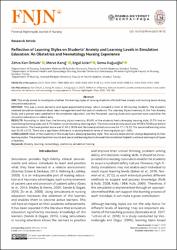| dc.contributor.author | Kan Öntürk, Zehra | |
| dc.contributor.author | Kanığ, Merve | |
| dc.contributor.author | Aslan, Ergül | |
| dc.contributor.author | Kuğuoğlu, Sema | |
| dc.date.accessioned | 2021-08-02T07:33:27Z | |
| dc.date.available | 2021-08-02T07:33:27Z | |
| dc.date.issued | 2021 | en_US |
| dc.identifier.citation | Kan Öntürk, Z., Kanığ, M., Aslan, E. ve Kuğuoğlu, S. (2021). Reflection of learning styles on students' anxiety and learning levels in simulation education: An obstetrics and neonatology nursing experience. Florence Nightingale Journal of Nursing, 29(2), 186-193. https://dx.doi.org/10.5152/FNJN.2021.19173 | en_US |
| dc.identifier.issn | 2147-8686 | |
| dc.identifier.uri | https://dx.doi.org/10.5152/FNJN.2021.19173 | |
| dc.identifier.uri | https://hdl.handle.net/20.500.12511/7639 | |
| dc.description.abstract | AIM: This study aimed to investigate whether the learning styles of nursing students affected their anxiety and learning levels during simulation education.
METHOD: This was a cross-sectional and quasi-experimental study, which included a total of 60 nursing students. The students received simulation education about labor management and first care of newborns. The Learning Styles Inventory III, the Trait Anxiety Scale, and a pretest were used before the simulation education, and the Perceived Learning Scale and a posttest were used after the simulation education to collect data.
RESULTS: According to data from the learning styles inventory, 81.6% of the students had a diverging learning style, 11.7% had an assimilating learning style, and 6.7% had an accommodating learning style. The mean state anxiety score was 49.83 +/- 10.59 just before the simulation. The mean pretest score was 51.50 +/- 16.96 and the mean posttest score was 54.17 +/- 15.22. The perceived learning score was 35.45 +/- 5.12. There was a significant difference in anxiety levels in terms of learning styles (p<.005).
CONCLUSION: Most of the students in this study had a diverging learning style. Their anxiety levels did not change depending on their learning styles. The pretest/posttest results and perceived learning levels showed that simulation helped to achieve learning in all types of learners. | en_US |
| dc.language.iso | eng | en_US |
| dc.publisher | Istanbul University | en_US |
| dc.rights | info:eu-repo/semantics/openAccess | en_US |
| dc.rights | Attribution-NonCommercial 4.0 International | * |
| dc.rights.uri | https://creativecommons.org/licenses/by-nc/4.0/ | * |
| dc.subject | Anxiety | en_US |
| dc.subject | Learning | en_US |
| dc.subject | Neonatology | en_US |
| dc.subject | Obstetrics | en_US |
| dc.subject | Simulation Training | en_US |
| dc.title | Reflection of learning styles on students' anxiety and learning levels in simulation education: An obstetrics and neonatology nursing experience | en_US |
| dc.type | article | en_US |
| dc.relation.ispartof | Florence Nightingale Journal of Nursing | en_US |
| dc.department | İstanbul Medipol Üniversitesi, Sağlık Bilimleri Fakültesi, Hemşirelik Bölümü | en_US |
| dc.authorid | 0000-0002-2794-1068 | en_US |
| dc.identifier.volume | 29 | en_US |
| dc.identifier.issue | 2 | en_US |
| dc.identifier.startpage | 186 | en_US |
| dc.identifier.endpage | 193 | en_US |
| dc.relation.publicationcategory | Makale - Uluslararası Hakemli Dergi - Kurum Öğretim Elemanı | en_US |
| dc.identifier.doi | 10.5152/FNJN.2021.19173 | en_US |



















